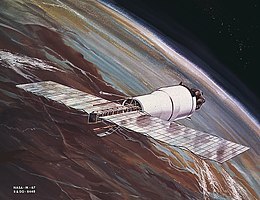 A Pegasus satellite in orbit | |
| Operator | NASA |
|---|---|
| COSPAR ID | 1965-060A |
| SATCAT no. | 01467 |
| Mission duration | 1 year (design) 3 years (achieved) |
| Spacecraft properties | |
| Spacecraft type | Pegasus |
| Manufacturer | Fairchild Hiller |
| Launch mass | 10,323 kilograms (22,758 lb) |
| Payload mass | 1,450 kilograms (3,200 lb) |
| Start of mission | |
| Launch date | 30 July 1965, 13:00:00 UTC |
| Rocket | Saturn I SA-10 |
| Launch site | Cape Canaveral LC-37B |
| End of mission | |
| Disposal | Decommissioned |
| Deactivated | 29 August 1968 |
| Decay date | 4 August 1969 |
| Orbital parameters | |
| Reference system | Geocentric |
| Regime | Low Earth |
| Perigee altitude | 516 kilometers (321 mi) |
| Apogee altitude | 536 kilometers (333 mi) |
| Inclination | 28.8 degrees |
| Period | 95.15 minutes |
| Epoch | 3 September 1965 |
Apollo micrometeoroid investigation | |
Pegasus 3 or III, also known as Pegasus C before launch, was an American satellite which was launched in 1965 to study micrometeoroid impacts in Low Earth orbit. It was the last of three Pegasus satellites to be launched, the previous two having been launched earlier the same year. It was manufactured by Fairchild Hiller, and operated by NASA.